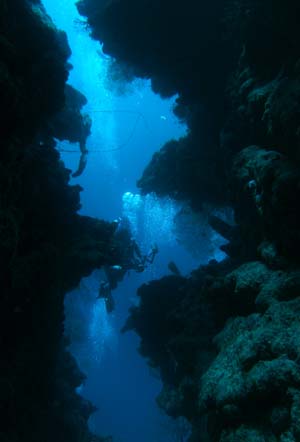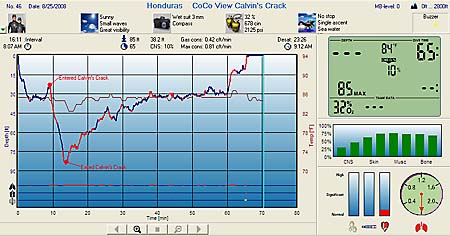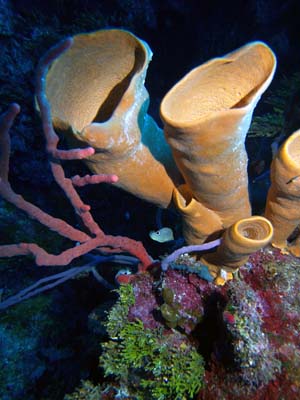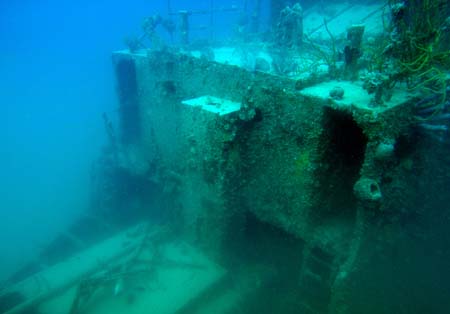« First ocean dive | Main | Contemplations on a day off »
August 25, 2008
Prince Albert and green blood
In "Silent World," published in 1953, Captain Jacques-Yves Cousteau describes a new type of fish they had found in the French Mediterranean off Marseille. They'd gone deep and speared a good-sized liche and the fish bled. The blood, however, was emerald green and that was quite unusual. Ever the scientist, Cousteau made sure they'd get this trophy to the surface so they could examine the green-blooded fish. They did and were anxious to show their find to the team, but as they ascended the green blood turned brown, then pink. On the surface the fish was bleeding red like any other. Cousteau probably slapped his head and went, "Of course! You cannot see red deeper than 15 or 20 feet or so." When I read that I thought it was pretty strange. No more. I bleed green, too.
 Whatever causes underwater nosebleeds struck me during a morning dive. The boat had taken us out to "Calvin's Crack," a gorgeous though somewhat oddly named dive site that's indeed a narrow crack in the reef (it was likely named after Calvin Bodden, friend of CoCo View founder Bill Evans). It descends all the way from a fairly shallow entrance area at maybe 30 feet of water to an opening to the ocean deep in the wall. The entrance is like a cave or cavern and you go in head-first, but it's not really an overhead environment as light remains visible through the top of the crack at all times.
Whatever causes underwater nosebleeds struck me during a morning dive. The boat had taken us out to "Calvin's Crack," a gorgeous though somewhat oddly named dive site that's indeed a narrow crack in the reef (it was likely named after Calvin Bodden, friend of CoCo View founder Bill Evans). It descends all the way from a fairly shallow entrance area at maybe 30 feet of water to an opening to the ocean deep in the wall. The entrance is like a cave or cavern and you go in head-first, but it's not really an overhead environment as light remains visible through the top of the crack at all times.
It is a wonderfully eery experience floating downward between walls of sheer rock to the left and right, from 30 feet to perhaps 80 or 90, with beams of light from the surface shining down from between the cliffs, and air bubbles from divers ahead of you rising in a silvery stream. Diving the crack is like floating through a rugged, narrow canyon with just enough room for a single diver. The sandy bottom of the crack descends until it opens on the side of the wall into the blue ocean at a depth of anywhere from 60 to 100 feet. I'd been nervous again before the dive, of course, but felt just fine going into and through the crack. It was all totally new to me and so I composed myself and finned through, not taking nearly enough time to look around and take it all in.
I exited Calvin's Crack at about 85 feet, with the bottom still well below me. It was over too soon, sort of like a rollercoaster ride at the carnival. The water felt noticeably colder once I emerged from the wall and was floating in the open ocean along the nearly vertical cliffs. Later, when I uploaded my dive computer data into my notebook I saw that the water temperature had dropped all of four degrees, from 86 to 82 degrees Fahrenheit. All thermoclines should be that mild.

Over the next 25 minutes we slowly worked our way along the luscious wall and back up to shallower water. I noticed that the left side of my Scubapro Frameless mask was getting pretty murky with liquid accumulating at the bottom. There is almost always a little bit of water seeping into a mask and it's no big deal once you know how to purge. My Frameless mask is as leak-proof as I've experienced (I have tried out a dozen masks or so) and I rarely ever have to clear my mask to get the water out. I didn't like the murky greenish water and wasn't sure where it came from until it turned red as I ascended and then I knew. Nose or sinus bleed. Looks emerald green at depth. Nothing to be alarmed about, but definitely something I could do without. I cleared out the mask as much as I could before entering the dive boat through the cut-out with the ladder in the bottom, but Jorge, our boat captain, noticed right away and actually looked a bit alarmed. He gave me tissues once I was on the boat and I ended up needing quite a few of them. So that was a pretty good nosebleed.
I decided to skip the morning's "drop-off" dive and head back to the dock on the boat. That gave me a chance to roam around CoCo View resort a bit, look at the dozens of hummingbirds excitedly competing for a spot on one of the sugarwater bird feeders, and check out the well equipped PADI 5-Star dive shop (Dockside Dive Center). I asked the dive master and other authorities about the cause of the nosebleeds and what one can do about it, but no one seems to know for sure. I have no clue what causes regular nosebleeds (which I have rarely ever gotten), let alone ones caused by diving. They call seats high up in a stadium the "nosebleed section," so I suppose pressure has something to do with it. Carol said many divers, including accomplished ones, have to deal with this and that it usually goes away after a number of dives. I sure hoped it'd go away for me.
 I did take the afternoon dive (Valley of the Kings), but made sure I stayed relatively shallow, never going deeper than 55 feet. The dive took us along a wall and then over an undulating reef plateau with lots to see. I think I'll never get tired of looking at the plants and sea creatures. I used to think real sponges looked like what my grand parents used in their bathroom. I had no idea they where tube-like structures in all forms, colors and sizes. Gliding through it all you never know what you'll see next. Many sea creatures have adapted themselves to a specific plant, mimicking shape, texture and color so they become nearly invisible against the backdrop of their host. Wonderful though it was, I felt a bit apprehensive after the green blood episode and so wasn't able to relax and enjoy as much as I should have. I did still have a bit of bleeding, but much less, and so I decided I was going to risk a second dive that afternoon. After surfacing and recuperating we asked the captain to take us to the wreck of the Prince Albert.
I did take the afternoon dive (Valley of the Kings), but made sure I stayed relatively shallow, never going deeper than 55 feet. The dive took us along a wall and then over an undulating reef plateau with lots to see. I think I'll never get tired of looking at the plants and sea creatures. I used to think real sponges looked like what my grand parents used in their bathroom. I had no idea they where tube-like structures in all forms, colors and sizes. Gliding through it all you never know what you'll see next. Many sea creatures have adapted themselves to a specific plant, mimicking shape, texture and color so they become nearly invisible against the backdrop of their host. Wonderful though it was, I felt a bit apprehensive after the green blood episode and so wasn't able to relax and enjoy as much as I should have. I did still have a bit of bleeding, but much less, and so I decided I was going to risk a second dive that afternoon. After surfacing and recuperating we asked the captain to take us to the wreck of the Prince Albert.
Not all wrecks are the same, and one sitting in 45 to 70 feet of water in a channel right outside of a dive resort is most definitely not in the same class as one much deeper somewhere in open water. But until I see one of them, if I ever will, as far as I am concerned, the Prince Albert is a real wreck and then some. It is a large iron vessel sitting upright. It was sunk almost 25 years ago specifically as a scuba attraction by the owners of the CoCo View resort. It has many openings to explore and has probably been proofed so it's safe for divers. Then again, it's still a wreck deep underwater and it can look very intimidating. The sheer mass of the wreck is humbling as you weightlessly glide along its coral and sponge-encrusted sides. The water whose clarity can be exceptional at the top of the wreck can dwindle to just a few feet at the sandy bottom. Plantlife has taken over and transformed the massive vessel of steel into a silent reef with dark gaping holes along the sides and on the top. It's all open for exploration without any supervision at all. I didn't have my divelight with me and so could not see what's inside. Not that I would have done so in the first place. Floating in darkness inside a rusted hull does not seem totally harmless. I must assume things are closed off enough so divers do not get lost, but it all did look forbidding and intimidating.
It is amazing how very quickly sealife takes over a sunken vessel. The seafans, sponges, and corrals of all kinds did not seem any different from those that grow on reefs and walls. I thought a wreck would be all mud and rust and sediment, but it's a living, teeming medley of plants and fish, and really quite indistinguishable from a reef. There are large, spindly plants that stick and fan out all over the place as well as the usual variety of sealife large and small. Fish and other critters are everywhere.

I thought of all the books I had read about divers exploring the Andrea Doria or the Empress of Ireland, and how those wrecks claim lives even from the very best. I don't think it's worth risking one's life for a porcellain plate from a sunken ship, but people know the level of risk they wish to take. Seeing the wreck of the Prince Albert gave me an idea of what it's all about. It was very real, very impressive, and a thrill.
Posted by conradb212 at August 25, 2008 4:11 PM








